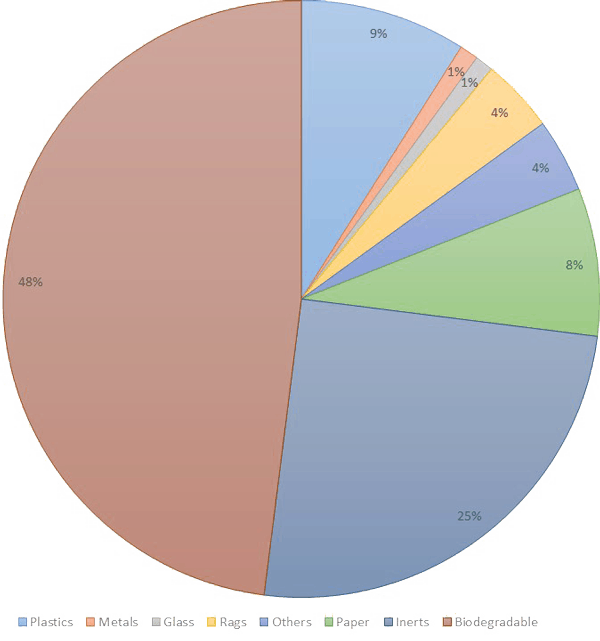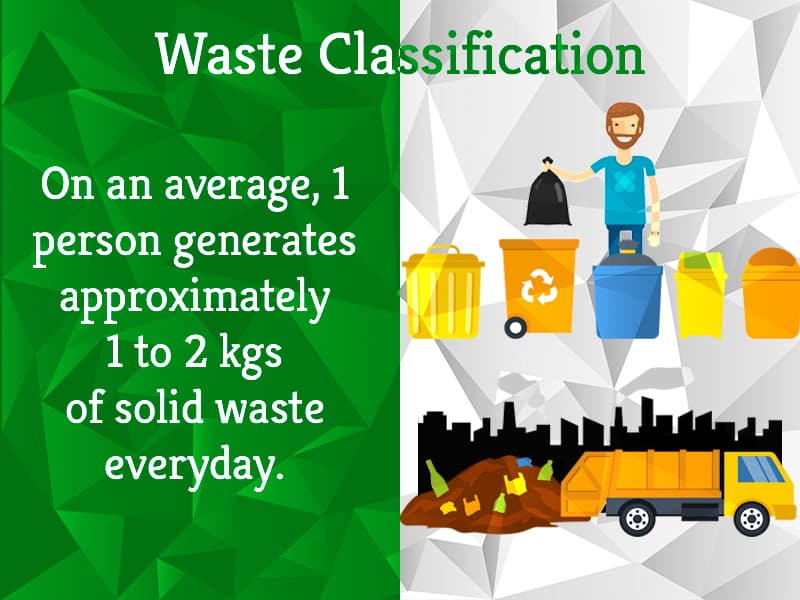Waste Classification is the first and most important step for Recycling, Reusing and Reducing.
Almost every activity results in the generation of solid waste. India is one of the largest waste generator in the world. On an average, a single person generates an average of 1 to 2 kgs of solid waste everyday. It is estimated that approximately 135-150 Million MT of solid waste is generated every day in India of which only 20% is treated.
On several surveys and studies, it was found that. it becomes next to impossible to treat solid waste because it is not segregated. It was also found that less than 10% of bulk waste generators segregate waste at source making municipal solid waste management ineffective and/or useless.
With the ever rising waste generation, civic authorities have started implementing Waste Segregation at Source.
Most of the solid waste generated comprises of daily use items that are found easily in every household. The composition of solid waste can be seen as below:

For this waste to be effectively segregated for proper management, it is very important to start classifying it correctly.
Waste Classification mainly occurs on the basis of their biological, chemical and physical properties and also on the basis of nature. For the purposes of segregation at source, waste is classified in to the following categories:
- Dry Waste – Refers to all items that are not considered wet/soiled items. This includes both recyclable and non-recyclable materials. Dry waste includes items such as bottles, cans, clothing, plastic, wood, glass, metals and paper.
- Wet Waste – Refers to all items that are organic like food items, soiled food wrappers, hygiene products, yard waste, tissues and paper towels, as well as any other soiled item that would contaminate the recyclables.
- Sanitary Waste – Refers to all liquid or solid waste originating solely from humans and human activities. (Can also include items from medical waste)
- Hazardous Household Waste – Refers to all household products that contain corrosive, toxic, ignitable, or reactive ingredients, other than used oil.
- E-Waste – Refers to all kinds of electronic waste.
Waste Classification of Common Household Items
The below table lists most common household items and their classification.
| Waste Item | Waste Category |
|---|---|
| Vegetable Peels | Wet Waste |
| Fruit Peels | Wet Waste |
| Rotten Vegetables | Wet Waste |
| Rotten Fruits | Wet Waste |
| Left over food | Wet Waste |
| Mango Seeds | Wet Waste |
| Used Tea Bags | Wet Waste |
| Used Coffee Powder from Filter | Wet Waste |
| Egg Shells | Wet Waste |
| Rotten Eggs | Wet Waste |
| Coconut Shells | Wet Waste |
| Tender Coconut Shells | Wet Waste |
| Used Leaves & Flowers from Puja | Wet Waste |
| Spoiled Spices | Wet Waste |
| Floor Sweeping Dust | Wet Waste |
| Meat & Non-Veg Food Remains | Wet Waste |
| Bones | Wet Waste |
| Mop Stick | Dry Waste |
| Used Mop Cloth | Dry Waste |
| Toilet Cleaning Brush | Dry Waste |
| Brush & Scrubs used for Cleaning | Dry Waste |
| Used & Dirty Floor Mats | Dry Waste |
| Bottles & Container of Pesticides | Dry Waste |
| Mosquito Repellent Refill Bottles | Hazardous Household Waste |
| Mosquito Repellent Mats | Hazardous Household Waste |
| Used Odonil | Hazardous Household Waste |
| Used Sanitary Pads | Sanitary Waste |
| Used Sanitary Cloths | Sanitary Waste |
| Used Condoms | Sanitary Waste |
| Used Syringes' | Sanitary Waste |
| Used Cotton & Bandage | Sanitary Waste |
| Used Tooth Brush | Dry Waste |
| Soap Covers | Dry Waste |
| Chocolate Wrappers | Dry Waste |
| Butter Paper (Wrapping for Butter) | Dry Waste |
| Milk Covers | Dry Waste |
| Ghee/Oil Packets | Dry Waste |
| Batter Packets | Dry Waste |
| Oil Cans | Dry Waste |
| Food Packagings | Wet Waste |
| Expired Food Packages | Dry Waste |
| Expired Medicines | Hazardous Household Waste |
| Tablets Covers | Hazardous Household Waste |
| Medicine Syrup Bottle | Hazardous Household Waste |
| Injection Bottles | Hazardous Household Waste |
| Other Medicinal Discards | Hazardous Household Waste |
| Finger or Toe Nails | Wet Waste |
| Any piece of cloth, paper stained with blood or any other medical or sanitary waste | Sanitary Waste |
| Newspaper | Dry Waste |
| Used Paper Pieces | Dry Waste |
| Old Posts | Dry Waste |
| Broken Stationary (Pen, Pencil,Eraser) | Dry Waste |
| Used Razor | Dry Waste |
| Used Razor Blades | Dry Waste |
| Empty Shampoo Bottle | Dry Waste |
| Empty Perfume Bottle | Dry Waste |
| Hair | Wet Waste |
| Left Over Pet Food | Wet Waste |
| Thermocol | Dry Waste |
| Batteries | E-Waste |
| CD's | E-Waste |
| CFL, Tube Light | Hazardous Household Waste |
| Printer Cartridges | E-Waste |
| Broken Watch Electronics | E-Waste |
| Broken Thermometer | Hazardous Household Waste |
| Diapers | Sanitary Waste |
| Empty Bottles of Floor & Toilet Cleaners | Hazardous Household Waste |
| Button Cells | E-Waste |
| Broken Glass | Dry Waste |
| Broken Household Plastic Items | Dry Waste |
| Aluminium Cans | Dry Waste |
| Used Pieces of Aluminium Foils | Dry Waste |
| Old Brooms | Dry Waste |
| Garden Leaves | Wet Waste |
| Weeds | Wet Waste |
| Dried Flowers | Wet Waste |
| Tissue Paper | Dry Waste |
| Tissue Paper (used for Medical or Sanitary Purposes) | Sanitary Waste |
| Used Cooking Oil | Hazardous Household Waste |
| Thermocol Balls from Bean Bags | Dry Waste |
| Small Broken Toys | Dry Waste |
| Bottles or Cans of Mosquito Sprays | Hazardous Household Waste |
| Used bottles, tubes, cans of shaving cream | Dry Waste |
| Flouroscents | Hazardous Household Waste |
| Button Cells | Hazardous Household Waste |
| Old Paints | Hazardous Household Waste |
| Used Oils | Wet Waste |
| Leather | Dry Waste |
| Rexine | Dry Waste |
| Furniture | Dry Waste |
| Bottles or Cans of Insecticide Sprays | Hazardous Household Waste |
| Bottles or Cans of Room Freshners | Hazardous Household Waste |
| Used bottles, tubes, cans of Deodrant | Dry Waste |
| Used bottles, tubes, cans of Creams, etc | Dry Waste |
| Broken/Damaged Computer Peripherals | E-Waste |
| Broken/Damaged Television | E-Waste |
| Broken/Damaged Radios | E-Waste |

